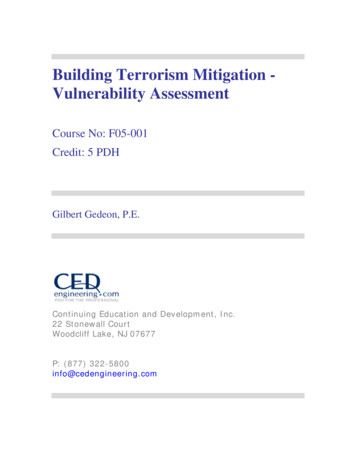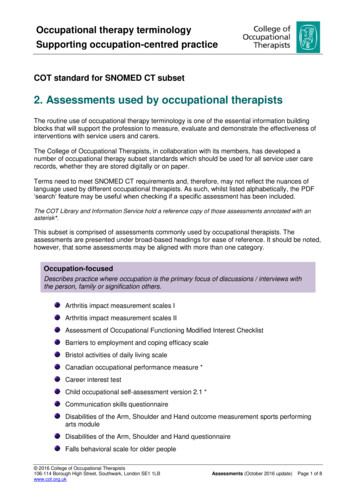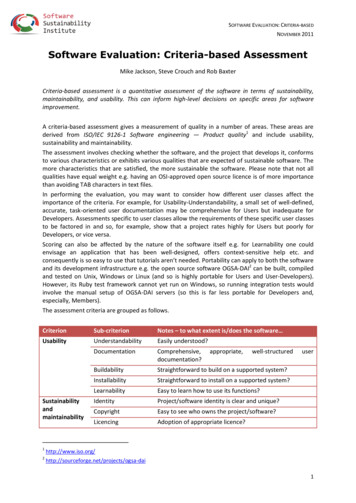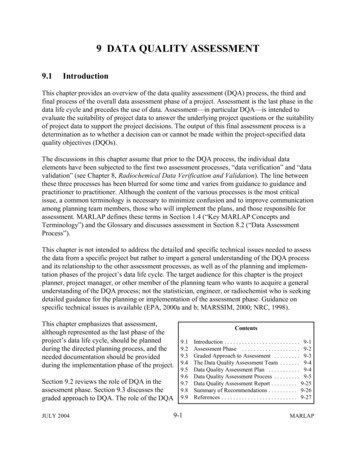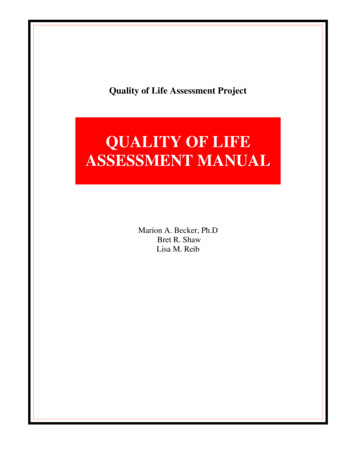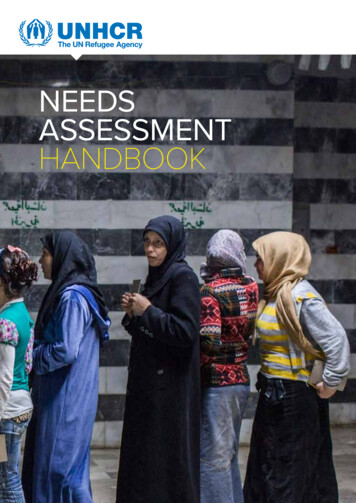
Transcription
NEEDSASSESSMENTHANDBOOK
CONTENTSForeword: UNHCR’s Strategic Approach to Needs Assessments4Acknowledgement 7Purpose 8Scope 8PART 1:Needs Assessment In UNHCR Operations11Needs Assessment Overview 11Definition and Purpose of Needs Assessments11Coordination Modalities for Needs Assessments13Types of Needs Assessments 15When to Conduct a Needs Assessment17Assessment Strategy 20Preparedness 20Roles and Responsibilities for Needs Assessments21Operations Management Cycle: All UNHCR Operations 21Refugee Situation: UNHCR-led Response 22IDP and Non-refugee Situations 24Mixed Situations 25Resourcing Assessments 26Principles in Conducting Needs Assessments29Key Principles for Needs Assessment 29Rights-Based Approach 31Participatory Approach, Community Engagement, and Accountability31Protection-centred Approach 33Link to Other Processes and Information Systems34Population Data Management and Needs Assessment34Registration of Refugees and Asylum-seekers in proGres 35IDP Enrolment for Assistance 36Profiling Displacement Situations 37Targeting 38Protection Information Management Systems 39The Needs Assessment Process 41Step 1: Understand Context 41Step 2: Plan the Needs Assessment 42Step 3: Collate and Collect Data 43Step 4: Draw Conclusions: Needs Analysis44Step 5: Share Information 45Additional Resources & Guidance 46 PART 1http://needsassessment.unhcr.org3
Foreword:UNHCR’s Strategic Approachto Needs Assessments‘We require needs assessments that are impartial, unbiased, comprehensive, context-sensitive,timely and up-to-date. Needs assessments must provide a sound evidence base for humanitarianresponse plans and prioritised appeals with due regard for specific accountabilities of mandatedagencies [ ] The needs assessment process must be coordinated, impartial, collaborative andfully transparent with a clear distinction between the analysis of data and the subsequent priori– The Grand Bargain, World Humanitarian Summit (Turkey, 23 May 2016) 1tisation and decision-making.’As a result of the World Humanitarian Summit in 2016, the Grand Bargain established 10commitments for aid organizations and donors to work together efficiently, transparently,and harmoniously in order to better deliver protection and assistance to the millions ofpeople facing emergency needs. One of these commitments calls for the improvement ofneeds assessments, notably by:1. Providing a single, comprehensive, cross-sectoral, methodologically sound, andimpartial overall assessment of needs for each crisis to inform strategic decisions;2. Coordinating and streamlining data collection to ensure compatibility, quality andcomparability, and avoid over-assessment and duplication;3. Sharing needs assessment data in a timely manner, with the appropriate mitigation of protection and privacy risks; and4. Prioritizing humanitarian response across sectors based on evidence establishedby the analysis.2Given that UNHCR is one of the signatories of the Grand Bargain, the agency’s NeedsAssessment Handbook and its accompanying online Needs Assessment Toolkit provideguidance on how to accomplish these objectives.UNHCR operations have been conducting collaborative, protection-sensitive needsassessments for years. However, the rigour demanded by donors and formalized by1The Grand Bargain: A Shared Commitment to Better Serve People in Need, Istanbul (Turkey),23 May 2016.2 With regard to needs assessments (Commitment 5), the Grand Bargain also stipulates that the signatories must‘dedicate resources and involve independent specialists within the clusters to strengthen data collection andanalysis in a fully transparent, collaborative process’; ‘commission independent reviews and evaluations of thequality of needs assessment findings and their use’; and, ‘conduct risk and vulnerability analysis with developmentpartners and local authorities’. Moreover, under Commitment 4 to ‘Reduce duplication and management costswith periodic functional review’, there is a commitment to ‘reduce the costs and measure the gained efficienciesof delivering assistance with technology (including green) and innovation’, for example by ‘expanding the use ofmobile technology for needs assessments/post-distribution monitoring’. These commitments will be dealt withthrough other UNHCR initiatives.4UNHCR NEEDS ASSESSMENT HANDBOOK
the cluster system to adequately address the needs and priorities of populations ofconcern now requires UNHCR to engage in more formal, methodologically sound, andtransparent processes for joint assessments and joint analysis.Joint and harmonized assessments lead to efficiencies, prevent the over-assessmentof populations of concern, and help establish a common inter-agency understanding ofa situation at the outset of a crisis and throughout the programme management cycle.Recognizing the importance of maintaining the link between needs assessments andmonitoring, regular joint needs analysis provides an evidence base for medium- andlong-term planning, including multi-year protection and solutions strategies. Similarly,to bridge the humanitarian and development gap, links are being strengthened with development frameworks and assessments such as UNDAF, Recovery and Peace-buildingAssessments (RPBA), and socio-economic research by actors such as the World Bank.This Handbook represents the first guidance UNHCR has produced on needs assessment that applies to all sectors, situations, methods, and populations of concern. Although the Handbook should not be considered policy, it serves the similar purposeof committing the Office and its staff members to a set of global principles, objectives,standards, procedures, and working methods. As the culmination of years of researchand broad consultations, it consolidates practices, standards, and guidance fromacross UNHCR and operationalizes the IASC Operational Guidance on CoordinatedAssessments in Humanitarian Crises.With this Handbook, UNHCR seeks to build on its strengths and core mandate to ensurethat the centrality of protection is mainstreamed in all needs assessments. For a humanitarian response to be protection-oriented, it is essential to understand and seek to prevent, mitigate, and/or end actual and potential risks. This requires a continuous analysisof the needs, risks, threats, vulnerabilities, and capacities of affected persons on the onehand, and of the commitment and capacities of duty bearers to address risk factors onthe other. Such an analysis provides the evidence base for programming, advocacy, andother activities that aim to change behaviours and policies in support of a more favourableprotection environment and better protection outcomes.3Needs assessment activities are characterized as any exercise conducted to understand the various needs of a population. In practice there are different assessment toolsand methods that can be used. It is good practice to establish a comprehensive assessment strategy that employs various assessment tools to meet the needs of each sector,based on the level and types of operational data required to achieve the identified purpose. See Annex 7 for more details on common assessments terms and relationships.43 IASC, Policy on Protection in Humanitarian Action, 2016.4 Note that there is sometimes confusion between needs assessments, the UNHCR Tool for ParticipatoryAssessments, and participatory approaches. All needs assessments must adhere to the principles and practicesof participatory approaches. While the scope and activities of participation may depend on the specific contextof each situation, participatory and community-based approaches are ‘the way UNHCR does business.’ Needsassessment activities, on the other hand, are characterized as an exercise conducted at a single point in timeto understand the various needs of a population. In practice there are many different assessment approachesand tools that can be used to undertake needs assessments, including highly qualitative approaches suchas the UNHCR Tool for Participatory Assessments and/or a more quantitative assessment approach such asIDP profiling (i.e. a household level, representative survey). Both methods are types of assessments within thebroader protection information management category of Needs Assessments, but they employ different datacollection techniques, which alter how operations can use the resulting data. PART 15
Regardless of the type of assessment chosen, participatory approaches must apply andguide all aspects of assessment activities. While the scope of participation may dependon the specific context of each situation, continuous participatory approaches are standard UNHCR practice.The Handbook is structured in two parts. The first, which is recommended for all audiences, defines need assessments and their different types; describes coordinationmodalities; outlines the roles and responsibilities of different actors in refugee situations,IDP situations, and mixed situations; provides an overview of the steps to conduct needsassessments and the principles that should guide them; and explains the relationshipbetween needs assessments and other information systems. The second part of theHandbook provides detailed practical guidance on how to conduct needs assessmentsin the field. It can be used as a reference text, with readers referring to specific steps andsections as needed based on their role in the operation or the needs assessment, andthe type of situation.In addition to the Handbook and supporting Toolkit, there is an e-learning programmethat is open to all interested staff members and UNHCR partners. The e-learning component is complimentary to the Handbook and provides further guidance on how to operationalize assessments. The programme illustrates case studies, field practices, andlessons learned from needs assessments within UNHCR operations.5We recognize that needs assessment practices and requirements evolve over time asnew operational environments emerge and new policies are introduced. For example,the Comprehensive Refugee Response Framework (CRRF) will amplify refugee hostpopulation voices in needs assessments. New innovations and strengthened humanitarian partnerships will continue to drive the need for and emergence of new techniques and standards. In order to respond to and capture those changes, UNHCR willregularly update the Needs Assessment Toolkit and has a dedicated email addressavailable to receive feedback on an ongoing basis (HQNA@unhcr.org). This is part ofour wider commitment to continue to professionalize needs assessment practices inorder to improve protection outcomes for the populations we serve.5 The Needs Assessment E-learning modules can be found on Learn and Connect. There is also an introductoryNeeds Assessment module within the Operational Data Management Learning Programme, ODMLP, (Module 25).6UNHCR NEEDS ASSESSMENT HANDBOOK
AcknowledgementThis Handbook was written under the supervision of Kimberly Roberson with assistance from Shelley Gornall, Robert Heyn, Lynnette Larsen, Gregg McDonald, RachelleCloutier, Kelly Ryan, and Cecilia Utas. The Needs Assessment Handbook is the product of close consultation and collaboration among UNHCR staff with key contributionsfrom the Bureaux; Division of International Protection; Division of Emergency, Securityand Supply; Division of Programme Support and Management; Innovation; and manydedicated UNHCR field colleagues.The Handbook is based on existing UNHCR guidance and practice on needs assessmentthat have been consolidated into a single reference source. It also reflects inter-agencyguidance and tools on needs assessments, including guidance from the AssessmentCapacities Project (ACAPS) and the IASC Needs Assessment Task Force. PART 17
PurposeThe purpose of the UNHCR Needs Assessment Handbook is twofold: To delineate UNHCR’s role in the coordination of humanitarian needs assessments; and To offer practical advice on how to appropriately design and conduct needs assessments and needs analyses for informed decision-making and needs-basedresponse planning.6The Handbook provides an assessment framework for UNHCR in a variety of contexts.ScopeThis Handbook is designed for use by all UNHCR staff and partners involved in needsassessments. This includes those responsible for overseeing an assessment and thosedirectly undertaking, managing, or coordinating such a process, whether specialists orgeneralists.The Handbook will apply in all UNHCR operations 7 and phases, from preparedness toemergency response to protracted situations, in four distinct planning and coordination models: UNHCR Operations Management Cycle; UNHCR-led response in refugee situations; UNHCR as cluster lead and cluster member in IDP situations and othernon-refugee humanitarian crises; and UNHCR in mixed situations with refugees and IDPs.8Note that, as a general matter, UNHCR does not provide in-kind humanitarian assistanceto stateless populations nor conduct regular needs assessments with regard to stateless populations. UNHCR implements its statelessness mandate to identify and protect6 UNHCR, Programme Manual (Chapter 4), 2016.7 This Handbook provides technical guidance that applies to all types of settings and groups of persons ofconcern to UNHCR, though approaches for assessments might differ and render a need for customizedguidance and tools, such as for stateless. References to available and relevant resources feature in the NeedsAssessment Toolkit.8 Note that while there are only three distinct planning models, in practice UNHCR often has to coordinate ina fourth situation: mixed. A mixed situation is one where the humanitarian community must respond to bothrefugees and IDPs.8UNHCR NEEDS ASSESSMENT HANDBOOK
stateless persons and to prevent and reduce statelessness primarily through advocacy with governments and others, and without humanitarian needs assessments. Whileneeds assessments generally are not conducted in statelessness situations, many of thegeneral information management and protection principles outlined in this Handbookwill apply to statelessness responses, too. For more information on UNHCR’s approachto statelessness, refer to: Statelessness: An Analytical Framework for Prevention, Reduction and Protection (UNHCR, 2008).Part 1 of this Handbook is particularly relevant for those responsible for decidingwhether to undertake a needs assessment and for ensuring the use of needs analysisin the programme cycle. Part 1 builds upon the UNHCR Programme Manual (Chapter4), Part II: Assessments.Part 2 is especially relevant for practitioners involved in the practicalities of undertakingneeds assessments in field operations. It describes the methodology and design requirements for a successful needs assessment and refers to standardized support toolsand best practices for UNHCR operations, which are available in an online toolbox.9 Part2 also refers to general external guidelines on good assessment practices; as there arenumerous specific assessment tools that change frequently, the main ones are presented in Annex 3 and are available in the toolbox.9 UNHCR, Needs Assessement Toolkit. PART 19
UNHCR and the wider humanitariancommunity undertake needsassessments to inform a broadspectrum of decisions. Put simply,if humanitarian actors do not knowwhat the needs are, how can theyrespond to them effectively?10UNHCR NEEDS ASSESSMENT HANDBOOK
Needs AssessmentIn UNHCR OperationsNeeds Assessment OverviewDefinition and Purpose of Needs AssessmentsNeeds assessments involve systematically gathering and analysing information relatingto the needs, conditions, and capacities of persons of concern – diverse women, men,girls, and boys of all ages, including those with specific needs – in order to determine gapsbetween a current situation and agreed standards. It must be conducted with the activeinvolvement of persons of concern.A needs assessment is defined as a data collection exercise usually conducted at a single point in time to gain anunderstanding of the protection issues, availability of resources, sources of problems and their impact on the affected population. (Protection Information Management [PIM] matrix, 2016) 10A needs assessment is triggered by a need to better understand a particular situation andthe conditions faced by populations of concern, whether in the context of a response toa sudden crisis or an ongoing planning effort during a protracted crisis.11 A needs assessment seeks to do some or all of the following: Identify the different protection needs and risks of diverse women, men, girls, andboys of concern, and establish priorities. Estimate the severity of conditions faced by diverse women, men, girls, and boysof concern, and establish priorities. Create a common understanding of differences in needs and reflect the diversity of conditions faced by relevant groups of persons of concern, including olderwomen and men; persons with disabilities; persons belonging to minority groups;lesbian, gay, bisexual, transgender and intersex persons (LGBTI); and others. Identify existing capacities and resources of persons of concern, including positive and negative coping mechanisms, as well as partners and governments. Inform emergency or longer-term/multi-year programme responses to close gapsbetween an affected population’s current status and the desired state.10 The PIM Matrix can be found here.11 Planning could refer to a humanitarian or refugee response plan or to long-term planning such as a multi-year,multi-partner protection and solutions strategy. PART 111NEEDS ASSESSMENTI N U N H C R O P E R AT I O N SPA RT 1
Support operational and strategic decision-making, including targeting.12 Avoid causing harm with humanitarian interventions. Inform the design of further assessments based in identified information gaps.A well planned and executed needs assessment – ideally conducted jointly or in collaboration with partners – provides stakeholders (UN agencies, governments, partners,persons of concern, etc.) with a common understanding of the situation, humanitarianneeds, and capacities. It assists in designing appropriate and proportionate programmesand activities by enabling evidence-based and transparent decision-making. Needs assessments can help provide the information required to make difficult prioritization decisions in light of constraints in resource allocation. An inability to prioritize humanitarianassistance and protection can lead to unnecessary suffering and even loss of life.The centrality of protection should be considered throughout the assessment and beparticipatory, aiming to include the full spectrum of age, gender, and diversity of persons of concern. The level of participation will vary with the accessibility of the groupsof persons of concern, size of the assessment, type of crisis, sectors to be assessed,and objectives.Needs assessments are critical to ensure core humanitarian principles are upheld, including the following: Humanitarian assistance and protection is both rights-based and needs-based: Persons of concern shouldbe involved in the identification of their priority needs, and receive assistance and protection relevant to andappropriate for their needs and in full respect of their rights. Humanitarian assistance and protection promotes and does not undermine safe local coping mechanismsand capacities: Affected populations are resilient and on their own will develop ways to cope with risks in orderto fulfil their needs. The respective needs of different population groups are identified and understood: Not all affected groupswill have the same needs. Not only will humanitarian needs differ for people of different sexes, ages, cultural,ethnic and religious backgrounds, sexual orientation, and disabilities but also based on factors that might increase the risk of protection incidents, on socio-economic factors, and on other issues. Decisions regarding humanitarian assistance and protection are based on verifiable information: In order toexplain the provision of assistance and ensure protection to populations – for instance, type of intervention,amount of assistance and protection, or the populations targeted – the humanitarian community needs verifiable information that provides both transparency and evidence for the decision-making process.Decisions that need to be taken when conducting a needs assessment includethe following: What information is needed to provide the necessary evidence base? Will the assessment serve multiple sectors or thematic areas? Will the assessment be a joint or harmonized assessment?12 While needs assessments can play a role in operational and strategic decision-making, frequently more indepth information is needed for selecting target populations.12UNHCR NEEDS ASSESSMENT HANDBOOK
Which geographic areas and populations will the assessment cover? What type of assessment is needed given the situation: initial, rapid, or in-depth? What is the host state’s capacity to lead and coordinate the needs assessment,and how can UNHCR and other partners support this leadership of the process?Some needs assessments focus on only one sector (e.g. shelter) or issue (e.g. sexualand gender-based violence), while others such as the Multi-Cluster/Sector Initial RapidAssessment (MIRA) focus on several sectors (e.g. shelter, CCCM). In general, multi-sectoral assessments aim to compare needs, severity, and priorities across sectors of interest and at a single point in time. Since the breadth of the assessment is as large asthe number of sectors covered, the depth of information collected is generally reduced.Multi-sectoral assessments are preferably used at the beginning of a crisis, after a substantial change in a situation, or at well-identified points during the year (e.g. to supportthe Humanitarian Needs Overview or the Refugee Response Plan) to provide a comprehensive overview of the situation and to inform overall response strategies.Sector-specific assessments allow for more in-depth understanding of key issues, risks,and capacities within sectors. These tend to be better adapted to support specific cluster or sector strategies, programmes, and operations.Coordination Modalities for Needs AssessmentsCoordination mechanisms around humanitarian needs assessments have changed inthe past decade due to the broader humanitarian reform process. Under this model,a UNHCR office may coordinate a multi-agency joint needs assessment in a refugeeemergency, participate in a multi-cluster joint assessment in an IDP context coordinatedby OCHA, coordinate a cluster-specific needs assessment as a cluster lead, or take ona lead role within a sector or multi-sector assessment in a mixed displacement situation. Additionally, in-depth needs assessments are fundamental for robust medium- andlong-term (i.e. multi-year) planning in protracted situations and for laying the foundationfor durable solutions in contexts of both refugees and IDPs.UNHCR follows the IASC Operational Guidance for Coordinated Assessments in Humanitarian Crises 13 to ensure effective coordination, produce comparable data, andpromote a shared vision of needs and situations. Coordinated assessments should beplanned and carried out through partnerships with government (where feasible), humanitarian actors, national civil society, and development actors with the participationof persons of concern. The results should be analysed and subsequently shared withthe broader humanitarian and development communities. In addition to saving time andresources, coordinating assessments ensures complementarity in data coverage andavoids duplication of efforts.13 IASC, Operational Guidance for Coordinated Assessment in Humanitarian Crises, 2012. PART 113
There are different degrees of coordination for assessments:Uncoordinated assessments are conducted without the knowledge of or without consideration for other ongoing initiatives. They often result in multiple assessments, theuse of different methodologies, and the production of various reports on similar issues,situations, or persons of concern. The results often are neither shared nor interoperable,and cannot be used to inform a joint analysis and common understanding of a situation.A lack of coordination of assessments also can cause harm to populations of concern,who may be asked multiple times about their needs by different actors, including aboutpotentially sensitive or traumatic issues.Coordinated assessments are planned and carried out in partnership, with resultsshared with the broader humanitarian and development communities, as well as withpersons of concern, to identify the needs, conditions, priorities, and capacities of affected populations. Such assessments range from inter- and intra-cluster/thematic jointassessments to harmonized single-agency assessments. The two types of coordinatedassessments are: Joint needs assessments occur when multiple organizations have an interest inusing similar data collection methodologies to conduct an assessment in specificgeographic locations, or when organizations have an interest in the same thematic area. Data collection, processing, and analysis take place as a single processamong agencies within and between clusters/thematic areas, and lead to the production of a jointly owned output (i.e. single report). Harmonized needs assessments are conducted by a single agency and providean alternative to joint assessments in situations where there is a compelling reason to do separate assessments, due to operational considerations, protectionconcerns, or the need for specialist data collectors or different methodologies.Harmonized needs assessments must adhere to agreed standards in order tofacilitate cross-analysis, including but not limited to geographic data standardsand agreed thematic indicators.The critical aspect of a coordinated assessment approach is ensuring the participationof key stakeholders in all steps of the process to promote common understanding ofthe objectives, data collection and analysis methodologies, findings, and priority issues.Table 1 summarizes the different types of coordinated approaches.14UNHCR NEEDS ASSESSMENT HANDBOOK
Table 1 Coordinated assessment modalitiesTypeDefinitionOutputImplementationJoint NeedsAssessmentData collection,processing, and analysisform a single processamong agencies. Allagencies and organizations involved in planningand design follow thesame methodology anduse the same tools.A single report representingthe agreed interpretation andanalysis of needs by severalagencies or organizations. Establish a multi-organization coalitionthrough which to pool resources tosupport the odologyüSingle report Agree with partners on commonmethodologies and data collectiontools including internationallyrecognized best practices forresearching, documenting, andmonitoring protection concerns. Conduct a joint analysis to agree onthe interpretation of eassessmentswith commonindicatorsüüStandardizedapproachData collection,processing, and analysisare conducted separately, adhering to sharedstandards such as theuse of key indicators andcommon operationaldatasets, includinggeographical standards.Multiple needs assessmentsreports or databases that canbe cross-analysed, aggregated, and used for a shared orjoint analysis. Agree with partners on whichpopulation classifications andindicators will be used across multipleneeds assessments. Use the IASC Common OperationalDatasets 14 and UNHCR data standards. Share needs assessments tocross-analyse results.üJoint analysisUncoordinated Datasets are notAssessmentsinteroperable, and resultscannot be used to informUNCOORDINATEDthe overall sessment’ leads torisks and harms that outweighbenefits for individuals andcommunities. Avoid thissituation using one of the twotechniques outlined above. Multiple disconnected assessmentreports that may or may not beavailable for distribution. Duplicatedor redundant needs assessments.Thematic or geographic gaps in needsassessment information.MethodologiesüMultiple ReportsTypes of Needs AssessmentsDifferent types of assessments are commonly used during humanitarian emergencies.Each is designed for responding to specific information needs and often corresponds toa particular point in the course of an emergency or programme cycle.Needs assessment types vary in depth, research method, time frame, and cost. Table2 outlines the three most common assessment types and distinguishes between thembased on several criteria.14 Common operational datasets (CODs) are predictable, core sets of data that are standardized among thehumanitarian community and serve to support operations. Fundamental operational datasets (FODs) aredatasets that are required to support multiple cluster/sector operations and that complement the CODs. UNHCRhas a responsibility both to update and to use the IASC CODs and FODs in its information systems. The datasetsare available at: n. PART 115
Table 2 Types of needs assessmentCriteriaInitial AssessmentRapid AssessmentIn-depth AssessmentObjectives Define scale and severity ofthe crisis. Estimate women, men,girls, and boys in need. Identify and locate affectedpopulations and groupsconsidering age, gender,and diversity. Establish key priorities. Define access constraints. Define impact of crisis. Estimate women, men, girls,and boys in need by populationgroups of concern. Assess severity of needs ofaffected groups and areas. Capture views of differentgroups of affected populationsthrough consultation. Establish key priorities withaffect
4 UNHCR NEEDS ASSESSMENT HANDBOOK 1 The Grand Bargain: A Shared Commitment to Better Serve People in Need, Istanbul (Turkey), 23 May 2016. 2 With regard to needs assessments (Commitment 5), th






